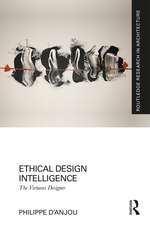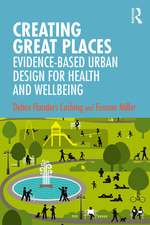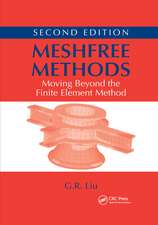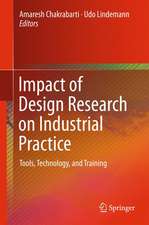CIRP Design 2012: Sustainable Product Development
Editat de Amaresh Chakrabartien Limba Engleză Paperback – 14 dec 2014
A variety of new insights into the product development process, as well as a host of methods and tools that are at the cutting edge of design research are discussed and explained covering a range of diverse topics. The areas covered include:
Sustainable design and manufacturing,
Design synthesis and creativity,
Global product development and product life cycle management,
Design for X (safety, reliability, manufacturability, etc.), and
Design taxonomy, ontology and standards.
CIRP Design 2012: Sustainable Product Development provides researchers in design, engineering and sustainability access to some of the latest, quality research in this area. Practitioners and educators of engineering design and sustainability will find an empirically validated suite of methods and tools that can be applied and taught to develop their practices.
| Toate formatele și edițiile | Preț | Express |
|---|---|---|
| Paperback (1) | 1224.06 lei 6-8 săpt. | |
| SPRINGER LONDON – 14 dec 2014 | 1224.06 lei 6-8 săpt. | |
| Hardback (1) | 1229.10 lei 6-8 săpt. | |
| SPRINGER LONDON – 20 noi 2012 | 1229.10 lei 6-8 săpt. |
Preț: 1224.06 lei
Preț vechi: 1492.75 lei
-18% Nou
Puncte Express: 1836
Preț estimativ în valută:
234.30€ • 254.59$ • 196.94£
234.30€ • 254.59$ • 196.94£
Carte tipărită la comandă
Livrare economică 21 aprilie-05 mai
Preluare comenzi: 021 569.72.76
Specificații
ISBN-13: 9781447160588
ISBN-10: 1447160584
Pagini: 452
Ilustrații: X, 442 p.
Dimensiuni: 155 x 235 x 24 mm
Greutate: 0.63 kg
Ediția:2013
Editura: SPRINGER LONDON
Colecția Springer
Locul publicării:London, United Kingdom
ISBN-10: 1447160584
Pagini: 452
Ilustrații: X, 442 p.
Dimensiuni: 155 x 235 x 24 mm
Greutate: 0.63 kg
Ediția:2013
Editura: SPRINGER LONDON
Colecția Springer
Locul publicării:London, United Kingdom
Public țintă
ResearchCuprins
Part 1. Design Theory, Methodology and Research Methodology.- Part 2. Creative and Inventive Design (TRIZ).- Part 3. Enabling Technologies & Tools.- Part 4. Global Product Development and PLM.- Part 5. Design For X (Safety, Manufacture, Assembly, Cost, Risk, Reliability, Modularity, etc.).- Part 6 Sustainable Design and Manufacturing.
Notă biografică
Amaresh Chakrabarti is a Professor of Engineering Design at Centre for Product Design and Manufacturing at Indian Institute of Science, Bangalore. He has a BE in Mechanical Engineering from University of Calcutta, India, ME in Mechanical Systems Design from Indian Institute of Science, Bangalore, and a PhD from University of Cambridge, UK in Engineering Design. After PhD, Prof. Chakrabarti led for ten years the Design Synthesis team at the EPSRC Centre for Excellence Engineering Design Centre at the University of Cambridge, before joining Indian Institute of Science. Prof. Chakrabarti has worked extensively in the areas of design synthesis and creativity, eco-design and sustainability, and knowledge engineering and management, and has written over two hundred papers in peer-reviewed journals, conferences and books.
He has written/edited six books, two of which have been published by Springer. He is the co-author of DRM - a design research methodology used widely around the world as a framework for carrying out engineering design research. Prof. Chakrabarti is an Associate Editor of AI EDAM Journal (Cambridge University Press), Area Editor for Research in Engineering Design Journal (Springer), Regional Editor for Journal for Remanufacturing (Springer), and Advisory Editor for Journal of Engineering Design (Taylor & Francis), Clean Technologies and Environmental Policy (Springer), International Journal of Design Creativity and Innovation (Taylor & Francis), and four other journals.
He is on the Advisory Board of Design Society, UK. He founded IDeASLab - the first laboratory in India for research into design creativity, sustainability and innovation. A Member of the CII National Committee on Design, India, he is also Programme chair for International Conferences on Research into Design (ICoRD), and a vice-Chair for AI in Design (AID) and Design Computing and Cognition (DCC) Conferences. Prof. Chakrabarti is an Honorary Fellow of theInstitution of Engineering Designers, UK.
He has written/edited six books, two of which have been published by Springer. He is the co-author of DRM - a design research methodology used widely around the world as a framework for carrying out engineering design research. Prof. Chakrabarti is an Associate Editor of AI EDAM Journal (Cambridge University Press), Area Editor for Research in Engineering Design Journal (Springer), Regional Editor for Journal for Remanufacturing (Springer), and Advisory Editor for Journal of Engineering Design (Taylor & Francis), Clean Technologies and Environmental Policy (Springer), International Journal of Design Creativity and Innovation (Taylor & Francis), and four other journals.
He is on the Advisory Board of Design Society, UK. He founded IDeASLab - the first laboratory in India for research into design creativity, sustainability and innovation. A Member of the CII National Committee on Design, India, he is also Programme chair for International Conferences on Research into Design (ICoRD), and a vice-Chair for AI in Design (AID) and Design Computing and Cognition (DCC) Conferences. Prof. Chakrabarti is an Honorary Fellow of theInstitution of Engineering Designers, UK.
Textul de pe ultima copertă
During its life cycle, a product produces waste that is over 20 times its weight. As such it is critical to develop products that are sustainable. Currently product development processes lack high quality methods and tools that are empirically validated to support development of sustainable products. This book is a compilation of over forty cutting edge international research papers from the 22nd CIRP International Design Conference, written by eminent researchers from 15 countries, on engineering design process, methods and tools, broadly for supporting sustainable product development.
A variety of new insights into the product development process, as well as a host of methods and tools that are at the cutting edge of design research are discussed and explained covering a range of diverse topics. The areas covered include:
·Sustainable design and manufacturing,
·Design synthesis and creativity,
·Global product development and product life cycle management,
·Design for X (safety, reliability, manufacturability, etc.), and
·Design taxonomy, ontology and standards.
CIRP Design 2012: Sustainable Product Development provides researchers in design, engineering and sustainability access to some of the latest, quality research in this area. Practitioners and educators of engineering design and sustainability will find an empirically validated suite of methods and tools that can be applied and taught to develop their practices.
A variety of new insights into the product development process, as well as a host of methods and tools that are at the cutting edge of design research are discussed and explained covering a range of diverse topics. The areas covered include:
·Sustainable design and manufacturing,
·Design synthesis and creativity,
·Global product development and product life cycle management,
·Design for X (safety, reliability, manufacturability, etc.), and
·Design taxonomy, ontology and standards.
CIRP Design 2012: Sustainable Product Development provides researchers in design, engineering and sustainability access to some of the latest, quality research in this area. Practitioners and educators of engineering design and sustainability will find an empirically validated suite of methods and tools that can be applied and taught to develop their practices.
Caracteristici
Compiles over forty cutting edge international research papers from the 22nd CIRP International Design Conference Details an empirically validated suite of methods and tools that can be taught and practiced Provides access to some of the latest, quality research in this area Includes supplementary material: sn.pub/extras
























